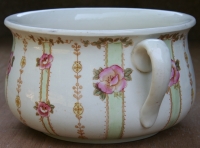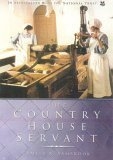-
History of:
- Resources about:
- More:
- Baby walkers
- Bakehouses
- Bed warmers
- Beer, ale mullers
- Besoms, broom-making
- Box, cabinet, and press beds
- Butter crocks, coolers
- Candle snuffers, tallow
- Clothes horses, airers
- Cooking on a peat fire
- Drying grounds
- Enamel cookware
- Fireplaces
- Irons for frills & ruffles
- Knitting sheaths, belts
- Laundry starch
- Log cabin beds
- Lye and chamber-lye
- Mangles
- Marseilles quilts
- Medieval beds
- Rag rugs
- Rushlights, dips & nips
- Straw mattresses
- Sugar cutters - nips & tongs
- Tablecloths
- Tinderboxes
- Washing bats and beetles
- Washing dollies
- List of all articles
Subscribe to RSS feed or get email updates.
About 100 pages of this book are on old laundry practices:
The Country House Servant from Amazon.com
or from Amazon.UK
The Lye-Stand
Insist on all your wood-ashes being saved to make the family soap. ...
... a common cask or barrel, placed on a form and raised about three feet from the ground, will answer very well. Let the two front legs of the stand be a little lower than the two behind, that the lye may drip the better. Have a hole bored with an auger in the bottom of the cask near the front, and fit in it a plug. When this is all ready, throw a gallon of lime on the bottom of the barrel or cask, fill it with new ashes, dampen them slightly, and suffer them so to remain for three weeks; then pour a plentiful supply of boiling water on the ashes, draw off the lye, and make your soap...
Mary Mason, The Young Housewife's Counsellor and Friend, 1875, North Carolina
London....three hundred years ago...this city was served with white soap in hard cakes, called Castile soap, from beyond sea; grey soap, speckled with white, from Bristol, sold here for 1d a pound...and black soap for an halfpenny a pound.
David Hughson, London, 1806
Lye and chamber lye
Ashes, lye-making, black soap, urine
 Lye soap was the soap of pioneer America, a mixture of boiled animal fat and lye:
lye made from water run through ashes from a wood fire. This had been the basic
recipe for many centuries and produced a dark soft soap known as black soap. The
lye could be used on its own for laundry, with soap as a second line of attack.
Lye soap was the soap of pioneer America, a mixture of boiled animal fat and lye:
lye made from water run through ashes from a wood fire. This had been the basic
recipe for many centuries and produced a dark soft soap known as black soap. The
lye could be used on its own for laundry, with soap as a second line of attack.
Lye can mean various different alkaline concoctions. Some people favoured burning particular kinds of plants for the best lye: seaweed ash produced fine Spanish soap for sale in England, while cherrywood was deprecated in the Appalachians. Apple and pear had a stronger bleaching effect than some wood ash. Areas with plentiful bracken burnt that for lye, and potato plants produced "weed ash" in Ireland. The dictionary (OED) says lye can be "any detergent material used in washing" and may even be “urine used as a detergent”.
Chamber lye was a useful laundry product, even though it couldn’t be made into soap. Precious urine collected from chamber pots, its many uses included stain removal and pre-wash soaking. It also removed natural oils from wool, and set dyes, not to mention its many uses in medicine. In some areas of the UK it was called "lant", "weeting", or "wash".
Before that you suffer it to be washed, lay it all night in urine, the next day rub all the spots in the urine as if you were washing in water; then lay it in more urine another night and then rub it again, and so do till you find they be quite out.
Hannah Woolley, The Compleat Servant-Maid, 1677
Bucking, soaking
>>> Also see the article on soaking in lye.
Soaking in lye, or sometimes chamber lye, was called "bucking". It dissolved grease, loosened dirt, and helped to bleach yellowed or greying linen. This could be part of a long, elaborate procedure that would not be undertaken lightly. Before the tradition of washing every Monday was familiar, some people had less frequent laundry rituals - with bucking as part of a grand wash session. Sometimes bucking would be followed by washing with soap, but not necessarily. A well-to-do household would have enough bed linen, table linen, and clothing so that an infrequent wash-day wasn't such a dirty idea as it sounds.
A bucking-tub was a common household item, seen in inventories on both sides of the Atlantic well into the 19th century. One of the Mayflower Pilgrims who died in 1633 left goods including "a bucking tub, a keeler [shallow tub], 2 payles a churne 3 traye", while a bucking-basket for carrying "fowle linnen" is part of a long joke about bucks and bucking in Shakespeare's Merry Wives of Windsor.
Some idea of what this might be like for people who could afford to keep heating quantities of water comes from a mid-19th century French housekeeping book. In Paris the laundry must be sent out to washerwomen, said another manual from the same period, but elsewhere you could proceed like this -
An ordinary wash has six stages.
Start with a pre-wash for linen needing to be laundered - everything cold water can remove will go at this stage.
Then put the linen in a tub, with the finer things at the bottom. This tub has a hole low down with a tap. Now pour cold water through the linen in the tub until the water comes out clear at the bottom.
Leave it soaking for 24 hours.
Next empty the water, and stretch a big bucking-cloth on top. Cover it with ashes from new wood, mixed with a little soda or potash. Heat some water to lukewarm and pour it over the bucking-cloth. This first pouring passes through the linen in the tub. Collect the liquid as it comes out through the tap, reheat it and pour it through again. Do you know how long this lasts? From 15 to 18 hours, because you must keep reheating the lye, a step at a time, over and over again until it is boiling as it passes through the bucking-cloth. .....
The fifth operation is soaping the lye-soaked linen, the sixth is rinsing with lots of water. Goodness knows how hard the washing-beetles (dolly-sticks) work during the soaping, beating with all their strength on the bundles of linen....
Mlle S. Ulliac Trémadeure, La Maîtresse de Maison, 1860, loosely translated
 20 June 2007
20 June 2007

Everyday Life in Early America from Amazon.com
or Amazon UK
For more on laundry history and old washing methods go to
>>>> History of laundry and
>>>> Laundry from 1800
Or you may like:
The grand wash and washdays
Washing bats
Washboards
Washing dollies
Laundry blue
See also:
History of ironing
Alternative spellings for lye: lee, lees, ley, lie for chamber lye: chamberly, chamberlye, chaymerly, chamber-lee
You may like our new sister site Home Things Past where you'll find articles about antiques, vintage kitchen stuff, crafts, and other things to do with home life in the past. There's space for comments and discussion too. Please do take a look and add your thoughts. (Comments don't appear instantly.)
For sources please refer to the books page, and/or the excerpts quoted on the pages of this website, and note that many links lead to museum sites. Feel free to ask if you're looking for a specific reference - feedback is always welcome anyway. Unfortunately, it's not possible to help you with queries about prices or valuation.




